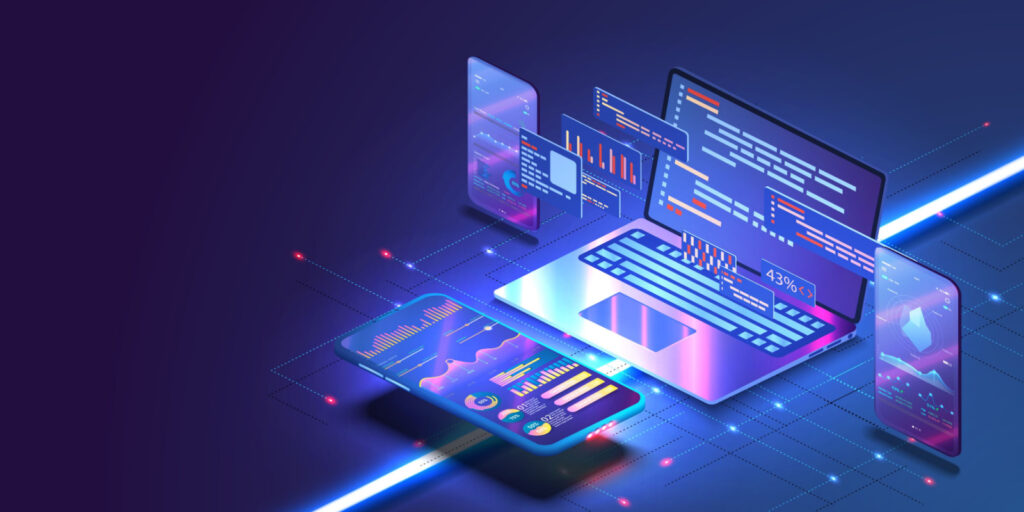The creation of applications has become crucial to contemporary company operations. The demand for software applications has grown significantly as a result of the quick development of technology and the increasing usage of mobile devices. Businesses also need specialized solutions that can respond to their particular demands and offer a seamless user experience, from mobile apps to online applications.
The different forms of application development, the steps involved in the process, and the most recent trends in the sector will all be covered in this article.

Modern Application Development
In order to produce software applications that are highly scalable, dependable, and simple to maintain, developers use a variety of modern application development approaches, techniques, and methodologies. The goal of agile modern application development is to produce software applications more quickly, with fewer bugs, and for less money.
Software is created iteratively in modern application development, with regular releases and ongoing user feedback. This enables developers to react swiftly to shifting needs, priorities, and requirements. In order to speed up the development process and decrease the time to market, modern application development also places a strong emphasis on automation, continuous integration, and continuous delivery (CI/CD). This strategy aims to increase the efficacy and efficiency of the development process while guaranteeing that the software application satisfies user requirements. In general, it is focused on producing high-quality software that is simple to deploy, administer, and maintain while yet satisfying users’ and organizations’ evolving needs.
Applications Development Types
Mobile and web application development are the two main categories. Web applications can be accessed through a web browser, whereas mobile applications are created specifically for mobile devices.
Application Development for Mobile
The process of developing software applications specifically for mobile devices like smartphones and tablets is known as mobile app development. These apps can be created for a number of operating systems, including Android, iOS, and Windows. Using the language unique to that platform, developers create native apps for a given platform. For instance, Android apps are developed using Java or Kotlin, but iOS apps are developed using Swift or Objective-C. In comparison to other types of apps, native apps offer higher performance, speed, and security.
On the other side, hybrid apps are a fusion of native and online apps. They are created utilizing native app containers and web technologies like HTML, CSS, and JavaScript. Although they might not be as quick as native apps, hybrid apps offer a better user experience than web apps.
Development of Web Application
The process of building software applications that can be accessed through a web browser is known as web application development. Applications are created by developers to run on a variety of hardware, including desktops, laptops, and mobile devices. Also, they create online apps using a variety of technologies, including HTML, CSS, JavaScript, and server-side scripting languages like PHP, Ruby on Rails, and Node.js.
Developers occasionally also use pre-made admin layouts. An admin template is a set of HTML, CSS, JavaScript, or other JavaScript libraries-created web pages that make up the backend user interface of an online application. It can reduce the amount of time and money needed to construct a web app.It also allows you to create SPAs and progressive web apps.
Application Development Stages
Each stage of the application development process is crucial to the project’s success. The many phases of developing an application are as follows:
Planning & Designing
The planning phase, which lays the groundwork for the remainder of the development process, is essential to the project’s success. The development team and the customer collaborate at this stage to determine the project’s goals, target market, and features and functionalities the application should have. The team also decides on the project’s schedules, budget, and scope.
Wireframes and application prototypes are created throughout the design phase. This stage consists of the application’s user interface (UI) and user experience (UX). The design team then collaborates with the development team to make sure the plan is technically doable and adheres to the project’s specifications. The design team at this company employs a variety of tools to create appealing software, including UI Kits, prototype tools (like Adobe and Figma), wireframes, etc.
Development & Testing
The actual coding happens during the development phase. Here, the development team builds the application using the necessary technologies and tools while adhering to the design standards. Each sprint that the development team completes results in a collection of features or functionalities.
The testing phase comprises verifying the application’s usability, performance, and functionality. To make sure the application functions as expected, the testing team employs a variety of testing techniques, including as unit testing, integration testing, system testing, usability testing, and user acceptability testing (UAT).
The testing phase is when the team finds and records any problems or flaws, then conveys them to the development team for resolution. The team also makes that the program is user-friendly, responsive, and accessible. The project’s success depends on the software testing phase, which makes sure the application is prepared for deployment.
Deployment & Maintenance
The application is released to the production environment at the deployment step. The processes necessary to deploy the application are laid out in a deployment strategy, which the deployment team executes. The team makes sure that there are no user interruptions or downtimes during application deployment. The project’s success depends on the deployment stage, which makes sure users can access the application.
The application’s continuous support and maintenance are part of the maintenance phase. To keep the program running at its peak, the development team offers ongoing maintenance and support. The staff also keeps an eye out for bugs or issues with the application and fixes them right away.
Conclusion
The development of applications, which includes a variety of types, stages, and trends, was briefly reviewed here. The goal of this article is to give you a thorough overview of the application development process, including what it entails. I hope this post was interesting and valuable to you.